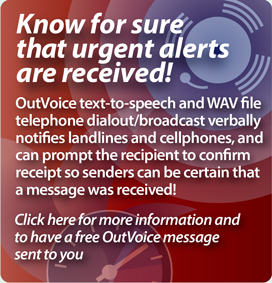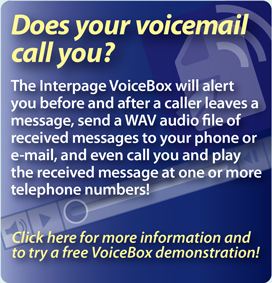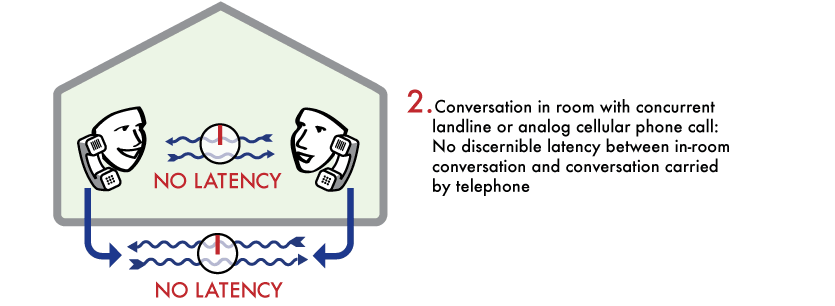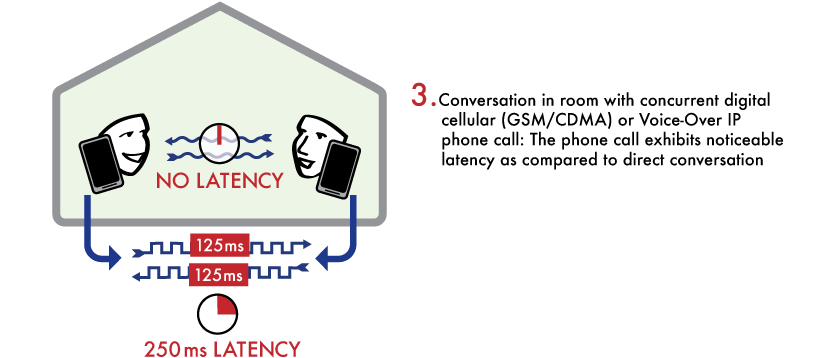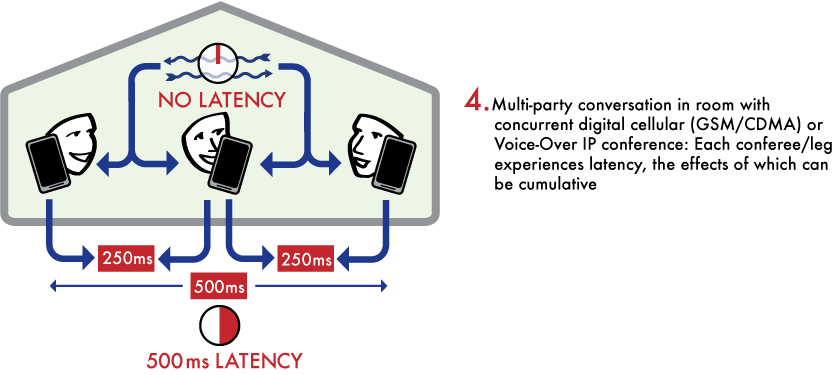Overview: A discussion of the speech latency and
conversational delay experienced in cellular, FiOS/Fiber-to-the-Home
(FTTH), U-Verse/Fiber-to-the-Curb, Voice-over-IP, and other digitized
telephone servcices and how it affects and degrades normal voice
conversation.
(Note: Before reading the discussion below, you may want
to call in to hear and test the voice delays on your cellphone and/or of your
current landline carrier; the dial-in
voice latency test is available 24-hours a day, at: (802)
359-9100 (this is a regular, local number), and follow the
recorded instructions. You may call with your number blocked for privacy
purposes, but we in any case do not market or sell any information about
you, nor will we contact you by any means to market to you.)
Have you ever placed a call on a cellphone/mobile phone, or used
a Voice-over-IP (VoIP), or landline Fiber-to-the-Home/FTTH service
such as FiOS, or Fiber-to-the-Curb/FTTC service such as AT&T U-Verse, and
found the (spoken) conversation with the called party to be slow, delayed,
echo-ish, difficult, or just not the same as conversing in person or over
a traditional landline (copper-wired) telephone?
Does the audio quality and discernable delay make the call strained, and
generally lack the ease of conversation which has always been offered by
traditional landline telephone calls?
Increasingly, this is due to "latency", that is, a delay or lag between
what is spoken by the caller and what is heard on the receiving end of a
call, which is becoming more common with the greater use of digitized
telephony technologies on both cellular and voice-over-ip (VoIP) networks.
Calls which used to have an immediate quality, as if the called parties
were speaking to each other in the same room, now sound like an older
satellite international call, with long delays between the time that the
calling party says something, and when the receiving party hears it,
making it difficult to have normal, immediate, unfettered conversations as
were previously possible over traditional phones (and analog cellular
phones as well).
Although digital cellular telephony has allowed for smaller handsets with
significantly longer battery life than earlier analog mobile phones, an
unfortunate trade-off of digital mobile phone service has been the
imposition of "latency" on every spoken voice conversation which takes
place via cellular service in the US and Canada (we are not aware as of
October 2014 of any analog cellular systems still in operation on the
North American mainland).
(Additional details about US cellular carrier audio and call quality
comparisons are available on the Cellular
Carrier Comparison page, detailing, in part, audio differences between
CDMA vs. GSM, as well as latency, audio delay, and conversational lag
issues of AT&T Wireless, Verizon, and T-Mobile/Sprint).
Similar audio problems are also evident in Voice-over-IP (VoIP)
residential (and to a lesser extent office) services, where the lower
monthly and call rates can be offset by a significant degradation in
terms of voice latency, delays in back-and-forth conversation, and other
qualities, such as echo-ing and the clipping words and sentences, or the
inability to properly transmit Touch Tones (also called DTMF, a Bell
System acronym for Dual Tone Multi-Frequency, as each touch tone consists
of two base tones), which often makes VoIP an overall inferior choice to
traditional landline/"circuit switched" service.
To compound matters further, since cellular carriers are often reticent or
unable to improve coverage in specific locations of poor coverage (see the
Cellular Carrier
Comparison for details and links to call drop lists for specific
carriers), they often ask their customers to rely on in-home Wifi calling,
which is essentially the same as using a VoIP service over a given
customer's WiFi network and internet connection. This adds another layer
of latency, as the call first has to traverse the home Wifi set-up and the
given customer's residential internet provider, and then connect over the
internet to the customer's cellular carrier, and then, after all
that, be routed out of the ceullular carrier's network to the
destination/dialed telephone number. Each one of the steps can add some
delay and audio distortion, which often makes home Wifi calling on
cellphones even more delayed, latent and distorted than calling using a
given carriers own's cellular (and not Wifi) network.
While consumers do generally have a choice in terms of whether
they use traditional landline service, Fiber-to-the-Home (FTTH)/FiOS-like
services (Verizon), Fiber-to-the-Curb (FTTC)/UVerse-like services (AT&T),
or VoIP from their homes or businesses (there are exceptions to the
ability to chose, such as Verizon's "mandatory copper conversion" where
copper customers are forced to use a demonstrably inferior FiOS; see
below), they do not have any choice when it comes to cellular
phones, as all cellular carriers no longer offer an analog product, and
customers must use a digital phone on every carrier's network.
So for landline customers who want to maintain the immediate and
high-quality nature of landline telephone service, or if they have burglar
alarms, remote fire and other monitoring systems, fax machines, or need to
reliably use equipment which responds to Touch Tone commands or transmit
data over modems or secure connections, there still remains, in most
cases, a choice as to what carrier a modality of transmission which they
may opt to use.
Unfortunately, this is not the case for cellular phones, and even with
"HD Voice" or LTE or the plethora of ephemeral promises as to the virtues
of 5G, cellular calls still don't sound at all like traditional, analog,
landline service, and often manifest so much voice distortion and latency
that a lot of the value inherrent in voice communication -- that is,
actually talking to someone else -- has been lost due to the
lag and lack of immediacy.
This is not to say that all digital communication is "bad" per se, and in
fact, most if not all long distance calls have been transmitted via
digital trunk lines (trunk lines which carry multiple calls for generally
longer distances) for many years in the US and Canada, but these were
designed to offer nearly no latency (similar to the end-to-end immediacy
of the older, pre-digital, analog long-distance trunks of the Bell System
and similar carriers), yet, when implemented starting in the early 1980's,
offered a significant improvement to the call set-up time and audio
quality of the analog long-distance trunks which had previously been used
for long-distance calling in North America.
Some readers who placed long distance calls before the year 2000 may
recall long set-up times after dialing a long-distance number, and/or a
background "hiss" or "white noise" during a call; these were gradually
eliminated with the implementation of digital trunks starting in the
early/mid-1980's, and one of the results of which was that long-distance
calls could be completed almost as fast as, and sounded just like, local
calls.
Digital telephony thus does not inherrently cause voice delays, audio
lags, and latency - some carriers, such as AT&T, did a much better job of
it than others, such as MCI (which was taken over and whose network
appears to be in part used by Verizon), and the difference in quality
between a long distance call on AT&T as compared to the
less-than-satisfactory call quality on Verizon (especially
internationally) is often obvious.
The effect of digitized trunks (often, but not exclusively, using fiber
optic cables) was even more noticeable on international calls, where the
extreme latency of a satellite connection (often 2 or more seconds of lag
tiome from the time the caller said "Hello!" to the time it was received
at the distant end!) often rendered a call useless for ordinary
conversation as any immediacy was vitiated by constant echoes and
interjections of "Yes? Did you hear that?" due to the delay in receiving a
response.)
Effectively, digital "switched circuit" (dedicated channel) telephony
allowed for long-distance and worldwide International calling which sounded
as good and as immediate (no latency/lag) as a local call. Local calls would
be generally be carried by a pair of copper wires to a local Central
Office/telephone exchange (presenting no latency or lag problems), and
long-distance calls beyond the local exchange were carried by digital
trunk lines, which also presented no latency or lag problems, and in
fact allowed calling within the US/Canada to sound as good from Miami to
Vancouver as it would calling locally across the street.
Cellular service underwent a similar transformation -- when cellular
mobile telephone service was introduced in the US/Canada in the early to
mid-1980s, all _voice_ connections were analog and thus offered
effectively immediate conversation with no latency similar to what a
landline call would sound like. Cellular service, known as Advanced Mobile
Phone Service (AMPS), used FM-radio signals for analog voice
conversations, and a digital channel to control which frequencies a given
mobile phone would access (as well as to perform ring, dialing, and other
control and administrative functions). Backhaul, or the connection from
the cellular switching center (the Mobile Telephone Switching Office, or
MTSO as it was then called) to the telephone network, was also provided
via high-quality, latency-free digital trunks, which provided for
landline-like sounding cellular calls. The only factors affecting the
quality of analog cellular were the engineering of the network, placement
and scope of towers, eliminating dead-spots, etc., but a well-planned
analog network had very similar sound qualities to that of analog landline
service.
Thus, analog cellular/AMPS, when implemented well, offered very similar
call characteristics to a landline phone -- immediate conversation (no
latency/lag), no digital distortion (a metallic or "robotic" "twang" often
evident in newer digital technologies, such as CDMA, and to a lesser
extent in GSM calls), and generally good voice quality. Unfortunately,
like FM radio, AMPS's FM signaling meant that mobile calls would be
subject to static and drop-outs similar to what a motorist would hear on
their FM radio while driving in areas where the analog cellular network
was not properly engineered to account for these problems.
More often than not, these cellular drop-outs, static, and other sound
quality issues were exacerbated by the (then) A (non-telephone company)
and B (local telephone company) analog cellular carriers' hesitance to
make significant investments both in service area build-outs to maintain
and improve call quality (for example, carriers were reticent to cover the
entirety of their service license areas or their "de-minimis" service
contour requirements in FCC parlance) as they were at the time not
convinced that AMPS would be a significant source of revenue, and the
effective duopoly of the "wireline" (B) carriers (such as NYNEX, Bell
Atlantic, Pac*Bell, etc.) and "non-wireline" (A) carriers (such as
"Cellular One", "Dobbson Cellular", and "Metro Mobile") and lack of
significant competition outside of the duopoly allowed the A and B
carriers to be lethargic and slow to improve service and add coverage to
any area other than certain highway corridors, very large cities, and
other areas where service enhancements would immediately translate into
higher revenue.
As service slowly expanded under the A/B carriers in the late 80's and
early 1990's (hindered to no small part by a federal regulatory apparatus
which did not keep up with the technology and treated AMPS as merely an
improved version of the earlier and significantly more limited Mobile
Telephone Service (MTS, 1940s) or Improved Mobile Telephone Service (IMTS,
1950's) of Bell and Independent service providers (especially with respect
to roaming and system integration), as the subscriber base of cellular
customers expanded, some carriers were approaching the limits of their
network's ability to handle all calls in a given area, and blocking and
failed calls (similar to IMTS' problems) became an increasingly prevalent
issue and impediment to good, reliable mobile service.
In many cases, had a given carrier made appropriate investments in its
analog network (such as Bell Atlantic Mobile prior to the NYNEX merger),
by dividing cells into smaller areas, providing more cell sites, etc.,
many of these congestion and blocking issues could have been mitigated,
but by the mid-1990's, customers were also demanding smaller, handheld
units which, due to their lower power, were even more prone at times to
the vagaries of FM radio, as well as phones with longer battery life.
(There were also fraud issues as well due to the less secure nature of ESN
validation on analog networks). Carriers wanted a cheaper way to expand
their networks without building out many, many more analog towers/sites,
and at the same time meet customers' expectations for smaller phones with
increased battery life, and thus the industry turned to digital cellular
technologies to address these issues.
With the early-2000's introduction of digital cellular service in the US
and Canada, and the subsequent phase-out of analog cellular commencing in
2007, a degree of immediacy and "real-time" communications was withdrawn
from the North American voice/mobile landscape. When compounded with the
decreasing number of traditional landlines and the increase in
mobile-to-mobile (or mobile-to-VoIP) calls, a significant and noticeable
lag/latency, has become increasingly evident in (voice) telephony,
and is in many ways a step backwards from the immediate, high-quality
calls which were commonplace only a few years before.
In nearly all cases, calls placed to/from cellular/mobile phones use one
of two digital protocols: GSM (which is also what most of the rest of the
world uses), and CDMA (used by Verizon, Sprint, their Mobile Virtual
Network Operators (MVNOs), resellers, and other smaller carriers in the
US/Canada, some carriers in China, and in a decreasingly small set of
other countries); CDMA and GSM will likely eventually "merge" into one
single protocol at some point in the distant future, and progress towards
this is being made by 4G/Long Term Evolution ("LTE") which carriers are
currently implementing.
Generally speaking, in terms of cellular voice calls, the GSM digital
protocol (used in the US by TMobile, AT&T Wireless, and some other smaller
regional carriers, resellers, and MVNOs) offers sound quality and an
overall call "experience" - in areas of strong coverage/signal
strength - which is noticeably superior to the CDMA protocol
(Verizon, Sprint), and sounds much more like a traditional landline/local
phone call.
While both protocols (GSM and CDMA) no longer suffer from analog static
and bounces off of buildings (multi-path), when all other things (such as
coverage and signal propagation) are equal, GSM clearly sounds better,
more lifelike, and more like a traditional landline call, while CDMA often
sounds "digitized", "metallic", and highly processed to the point that is
is clearly obvious that the caller is using a CDMA cellphone. Music is
also much more distorted over a CDMA phone and often "fades out" during
long "music on hold" periods, giving the caller the impression that the
called party who put the caller on hold has hung up.
Latency and lagging audio problems can also be compounded by "backhaul",
which, as noted above, is the way the cellular carriers connect to the
telephone network (which would affect cellular to landline calls, as
potentially also affect cellular to cellular calls between different
carriers), and also by the type of phone service a given landline
subscriber uses, such as analog/copper (the highest quality, no latency)),
FiOS or Fiber-to-the-Home services (lesser quality, higher latency), Voice
over IP or VoIP (generally the lowest quality and highest latency.)
Audio/speech delays and distortion can also be augmented by the use of
Voice over IP to handle the local leg of a cellular-to-landline calls:
With VoIP calls, quality suffers to varying degrees based on the VoIP
service provider, type of data compression, and the customer's internet
connection (speed, latency, packet loss, intergration and connection
points to the internet backbone, etc, all of which do not currently affect
cellular/voice calls), and thus call quality is very "hit or miss"
depending on these factors as well as the overall quality of the given
VoIP carrier, and thus VoIP can make a great deal of difference to the
degree of voice delay or call characteristics of any call, and will
compound the delay if used to place/receive calls from a (digital)
cellular phone.
(As the issues affecting and/or limiting the quality of VoIP calls are
often beyond the control of only the carrier, and depend to a significant
degree on the given customer's internet connection and that connection's
end to end carrier (or more than one carrier), most of the following
discussion will treat VoIP as a generalized aggregate of services, with
some degree of latency over that of traditional digital long-haul
telephony.)
So besides the latency and audio lag and distortion inherent in digital
cellular service, the use of poor backaul from the cellular carrier to the
telephone network, and/or the use non-analog/non-copper services like VoIP
or FiOS for the "local loop" leg of the call (from the network a given
landline home or office phone) can each add to and compound the problem
of conversational delay and odd-sounding voice and call characteristics.
Between the two predominant digital cellular voice protocols, CDMA and
GSM, one of the most significant conversational and voice-quality
advantages offered by the GSM protocol is a somewhat lower "latency" than
CDMA. That is, if an AT&T Wireless customer were to call a traditional
landline, and say "Hello!", the called landline party may have a 1/10th of
a second (100 millisecond) delay from the time "Hello" is uttered on the
TMO phone to the time the called party hears the word "Hello". That is, it
takes 1/10th of a second for the cellular/ATT Wireless caller's
voice/audio (the word "Hello") to reach the called landline party on their
phone due to the inherent delay incurred in the digitization of the word
"Hello" on the cellular phone, and the subsequent conversion back to
analog on at the cellular carrier's "switch" for transmission over the
landline network to the called party. (Note: these delay/latency times are
not necessarily exact measurements, but are used to exemplify the
differences in audio delay between landline, VoIP, TDMA and CDMA phones).
CDMA phones offer a longer delay/greater latency (not by much, but
noticeably, especially when a CDMA phone calls another CDMA phone), which,
combined with the other "unnatural" voice transmission characteristics
mentioned above, makes CDMA noticeably more difficult to have
"landline-quality", natural conversations with.
As both GSM and CDMA require digitization of voice on the
cellphone/handset itself and conversion back to analog when the signal
reaches the subscriber's long-distance ("backhaul") carrier, latency/lag is
thus _inherent_ in both GSM and CDMA digital protocols (or any digital
protocol), as it takes time for the analog (voice) sounds uttered into the
cellphone to be converted to digital signaling (digitized) and the
converted back to analog for transmission to the dialed number.
(Note: Most if not all calls in the US/Canada are digitized - cellular AND
landline; however, the "codecs" (processors which digitize and
"un-digitize" voice and sound) used in traditional landline telephone,
such as long distance, are significantly faster and sample voice and
considerably higher rates, which makes the digitization "effect" on
long-distance calls un-noticeable.)
While the latency from a single cell phone (GSM or CDMA) to a landline may
not be noticeable by some, on cellphone to cellphone calls, or cellphone
to FiOS or Voice-over-IP phone calls (Voip and FiOS, also digital, suffers
some lagging audio as well, which varies based on the given Voip carrier
and the data network/internet connection used to carry the Voip call),
each additional digital "step" adds more latency, making the delay more
noticeable.
As an example, and to demonstrate and test the latency of a given cellular
carrier (or Voip carrier, or any digital voice carrier), first establish a
baseline, eg, that of normal conversation, in person, with "person A" and
"person B" in the same room.
